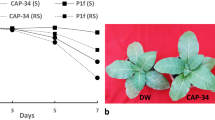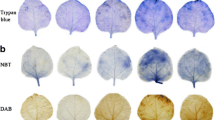Abstract
Pokeweed antiviral protein II (PAPII), a 30 kDa protein isolated from leaves of Phytolacca americana, inhibits translation by catalytically removing a specific adenine residue from the large rRNA of the 60S subunit of eukaryotic ribosomes. The protein sequence of PAPII shows only 41% identity to PAP and PAP-S, two other antiviral proteins isolated from pokeweed. We isolated a cDNA corresponding to PAPII and introduced it into tobacco plants. PAPII expressed in transgenic tobacco was correctly processed to the mature form as in pokeweed and accumulated to at least 10-fold higher levels than wild-type PAP. We had previously observed a significant decrease in transformation frequency with PAP and recovered only two transgenic lines expressing 1–2 ng per mg protein. In contrast, eight different transgenic lines expressing up to 250 ng/mg PAPII were recovered, indicating that PAPII is less toxic than PAP. Two symptomless transgenic lines expressing PAPII were resistant to tobacco mosaic virus, potato virus X and the fungal pathogen Rhizoctonia solani. The level of viral and fungal resistance observed correlated well with the amount of PAPII protein accumulated. Pathogenesis-related protein PR1 was constitutively expressed in transgenic lines expressing PAPII. Although PR1 was constitutively expressed, no increase in salicylic acid levels was detected, indicating that PAPII may elicit a salicylic acid-independent signal transduction pathway.
Similar content being viewed by others
References
Barbieri L, Aron GM, Irvin JD, Stirpe F: Purification and partial characterization of another form of the antiviral protein from seeds of Phytolacca americana L (pokeweed). Biochem J 203: 55–59 (1982).
Barbieri L, Battelli MG, Stirpe F: Ribosome-inactivating protein from plants. Biochim Biophy Acta 1154: 237–282 (1993).
Barbieri L, Valbones P, Bonora E, Gorini P, Bolognesi A, Stirpe F: Polynucleotide-adenosine glycosidase activity of ribosome-inactivating proteins – effect on DNA, RNA and Poly(A). Nucl Acids Res 25: 518–522 (1997).
Bjorn MJ, Larrick J, Piatak M, Wilson KJ: Characterization of translational inhibitors from Phytolacca americana. Aminoterminal sequence determination and antibody-inhibitor conjugates. Biochim Biophys Acta 790: 154–63 (1984).
Gorschen E, Dunaeva M, Hause B, Reeh I, Wasternack C, Parthier B: Expression of ribosome-inactivating protein JIP60 from barley in transgenic tobacco leads to an abnormal phenotype and alterations on the level of translation. Planta 202: 470–478 (1997).
Harlow E, Lane D: Immunoblotting. In: Antibodies: A Laboratory Manual, pp. 471–510. Cold Spring Harbor Laboratory, Cold Spring Harbor, NY (1988).
Hong Y, Saunders K, Hartley MR, Stanley J: Resistance to germinivirus infection by virus-induced expression of dianthin in transgenic plants. Virology 220: 119–127 (1996).
Hur Y, Hwang DJ, Zoubenko O, Coetzer C, Uckun FM, Tumer NE: Isolation and characterization of pokeweed antiviral protein mutations in Saccharomyces cerevisiae: identification of residues important for toxicity. Proc Natl Acad Sci USA 92: 8448–8452 (1995).
Irvin JD: Purification and partial characterization of the antiviral protein from Phytolacca americana which inhibits eukaryotic protein synthesis. Arch Biochem Biophys 169: 522–528 (1975).
Irvin JD, Kelly T, Robertus JD: Purification and properties of a second antiviral protein from Phytolacca americana which inactivates eukaryotic ribosomes. Arch Biochem Biophys 200: 418–421 (1980).
Irvin JD, Uckun FM: Pokeweed antiviral protein: ribosome inactivation and therapeutic applications. Pharmacol Ther 55: 279–302 (1992).
Irvin JD: Antiviral proteins from Phytolacca. In: Chessin M, De Borde D, Zipf A (eds) Antiviral Proteins in Higher Plants, pp. 65–59. CRC Press, Boca Rata, FL (1995).
Jach G, Gornhardt B, Mundy J, Logemann J, Pinsdorf E, Leah R, Schell J, Maas C: Enhanced quantitative resistance against fungal disease by combinatorial expression of different barley antifungal proteins in transgenic tobacco. Plant J 8: 97–109 (1995).
Jordanov MS, Pribnov D, Magun JL, Dinh TH, Pearson JA, Chen SLY, Magun BE: Ribotoxic stress response: Activation of the stress-activated protein kinase JNK1 by inhibitors of the peptidyl transferase reaction and by sequence-specific RNA damage to the β-sarcin/ricin loop in the 28S rRNA. Mol Cell Biol 17: 3373–3381 (1997).
Lam YH, Wong YS, Wang B, Wong RNS, Yeung HW, Shaw PC: Use of trichosanthin to reduce infection by turnip mosaic virus. Plant Sci 114: 111–117 (1996).
Leah R, Tommerup H, Svendsen I, Mundy J: Biochemical and molecular characterization of three barley seed proteins with antifungal properties. J Biol Chem 266: 1564–1573 (1991).
Lodge JK, Kaniewski WK, Tumer NE: Broad spectrum virus resistance in transgenic plants expressing pokeweed antiviral proteins. Proc Natl Acad Sci USA 90: 7089–7093 (1993).
Logemann J, Jach G, Tommerup H, Mundy J, Schell J: Expression of barley ribosome-inactivating protein leads to increased fungal protection in transgenic tobacco plants. Bio/technology 10: 305–308 (1992).
Poyet JL, Radom J, Hoeveler A: Isolation and characterization of a cDNA clone encoding the pokeweed antiviral protein II from Phytolacca americana and its expression in E. coli. FEBS Lett 347: 268–272 (1994).
Rapak A, Falnes PO, Olsnes S: Retrograde transport of mutant ricin to the endoplasmic reticulum with subsequent translocation to cytosol. Proc Natl Acad Sci USA 94: 3783–3788 (1997).
Ready MP, Brown DT, Robertus JD: Extracellular localization of pokeweed antiviral protein. Proc Natl Acad Sci USA 83: 5053–5056 (1986).
Reinbothe S, Mollenhauer B, Reinbothe C: JIPs and RIPs: the regulation of plant gene expression by jasmonates in response to environmental cues and pathogens. Plant Cell 6: 1197–1209 (1994).
Rippmann JF, Michalowski CB, Nelson DE, Bohnert HJ: Induction of a ribosome-inactivating protein upon environmental stress. Plant Mol Biol 35: 701–709 (1997).
Smirnov S, Shulaev V, Tumer NE: Expression of pokeweed antiviral protein in transgenic plants induces virus resistance in grafted wild-type plants independently of salicylic acid accumulation and pathogenesis-related protein synthesis. Plant Physiol 114: 1113–1121 (1997).
Stirpe F, Barbieri L, Gorini P, Valbonesi P, Bolognesi A, Polito L: Activities associated with the presence of ribosome inactivating proteins increase in senescent and stressed leaves. FEBS Lett 382: 309–312 (1996).
Taylor BE, Irvin JD: Depurination of plant ribosomes by pokeweed antiviral protein. FEBS Lett 273: 144–146 (1990).
Taylor S, Massiah A, Lomonossoff G, Roberts LM, Lord JM, Hartley M: Correlation between the activities of five ribosomeinactivating protein in depurination of tobacco ribosomes and inhibition of tobacco mosaic virus infection. Plant J 5: 827–835 (1994).
Tumer NE, Hwang DJ, Bonness M: C-terminal mutant of pokeweed antiviral protein inhibits viral infection but does not depurinate host ribosomes. Proc Natl Acad Sci USA 94: 3866–3871 (1997).
Waddick KG, Myers DE, Gunther R, Chelstrom LM, Chandan-Langlie M, Irvin JD, Tumer N, Uckun FM: In vitro and in vivo antileukemic activity of B43-pokeweed antiviral protein against radiation-resistant human B-cell precursor leukemia cells. Blood 86: 4228–4233 (1995).
Yalpani N, Shulaev V, Raskin I: Endogenous salicylic acid levels correlate with accumulation of pathogenesis-related proteins and virus resistance in tobacco. Phytopathology. 83: 702–708 (1993).
Zoubenko O, Uckun F, Hur Y, Chet I, Tumer NE: Plant resistance to fungal infection induced by nontoxic pokeweed antiviral protein mutants. Nature/Biotechnology 15, 992–996 (1997).
Author information
Authors and Affiliations
Rights and permissions
About this article
Cite this article
Wang, P., Zoubenko, O. & Tumer, N.E. Reduced toxicity and broad spectrum resistance to viral and fungal infection in transgenic plants expressing pokeweed antiviral protein II. Plant Mol Biol 38, 957–964 (1998). https://doi.org/10.1023/A:1006084925016
Issue Date:
DOI: https://doi.org/10.1023/A:1006084925016




